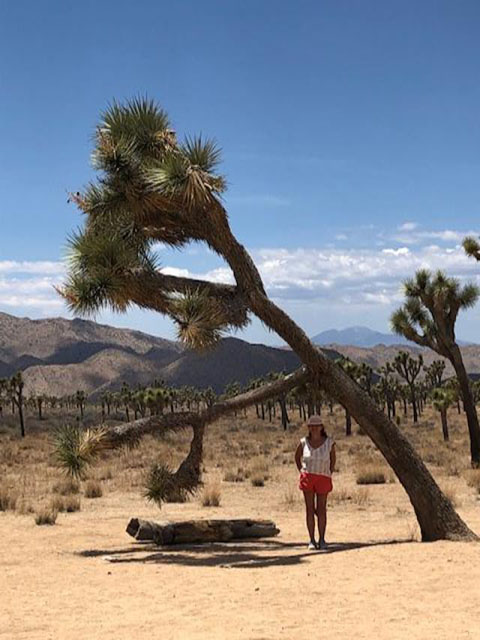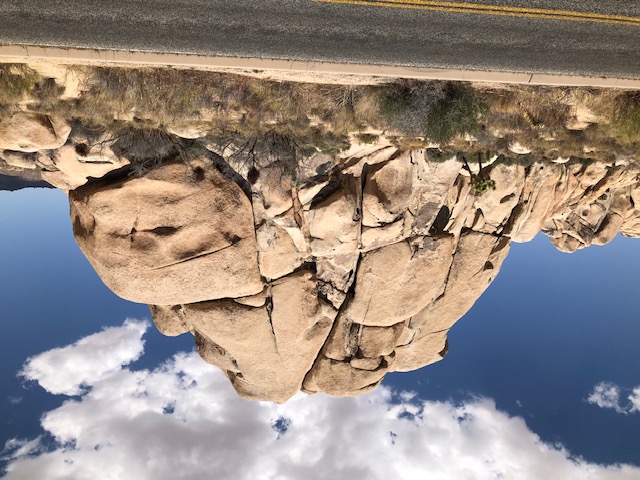Dali-esque National Park Visit Arouses Surrealistic Expression of Recent Unsettled Time


 A bizarre trip. That’s been my existence for two years. I’ve always been healthy and fit. But the surrealism began with an illness that landed me in the hospital for two, weeklong stays – the second caused by piss-poor follow-up care from the first stay – and several months of isolated recovery. Mix in the COVID-19 scare and quarantines, George Floyd’s televised murder, the 2020 election, January 6, 2021, and the sudden shocking loss of my beloved kitty, Tigre, from a blood clot due to unknown heart disease, and boy, am I primed to express my disorientation through some fantastical abstract paintings.
A bizarre trip. That’s been my existence for two years. I’ve always been healthy and fit. But the surrealism began with an illness that landed me in the hospital for two, weeklong stays – the second caused by piss-poor follow-up care from the first stay – and several months of isolated recovery. Mix in the COVID-19 scare and quarantines, George Floyd’s televised murder, the 2020 election, January 6, 2021, and the sudden shocking loss of my beloved kitty, Tigre, from a blood clot due to unknown heart disease, and boy, am I primed to express my disorientation through some fantastical abstract paintings.
 A perfect inspiration is the Joshua Tree National Park. In early June, I visited the high desert setting 50 miles north of Palm Springs, Calif. Spanning 792,510 acres at 4,000-plus feet elevation, the arid phantasmagorical landscape is located at the merging points of the Mojave, Colorado, and Sonoran Deserts.
A perfect inspiration is the Joshua Tree National Park. In early June, I visited the high desert setting 50 miles north of Palm Springs, Calif. Spanning 792,510 acres at 4,000-plus feet elevation, the arid phantasmagorical landscape is located at the merging points of the Mojave, Colorado, and Sonoran Deserts.
It’s Salvador Dali live. An afternoon sojourn entranced. My eyes. My body. My psyche. The 95-degree dry heat rendered me sluggish, dazed, dripping. The vista was starkly strange . . .a colossal natural sculpture garden of jumbled globs of stacked granite boulders of infinite sizes and shapes peppered amidst forests of tortured trees with spindly twisted and gnarled branches shooting up from expansive endless stretches of sandy earth.
Although wildflowers bloom for a few weeks in the spring and plants like cacti, ocotillo, smoke trees, and brittle brush endure the extremes, the main flora is the Joshua tree. Mormon travelers in the 1850s came up with the name because this member of the agave family and dominant plant of the Mojave Desert looked like the prophet Joshua pointing them to the Promised Land. The trees grew – some up to 30 feet or more -- over a vast range thanks to the fertilization during the Ice Age by the giant 500-pound Shasta ground sloth that ate and then spread the tree seeds via its dung. Spring flowerings cause the random branching and infinite variety of shapes; after white flowers blossom at branch tips, the branch splits, then each branch splits again with another flowering. They look anguished, even haunted, but beautiful in their ugliness.
 The boulder piles hypnotize as well. They have been formed by geological forces that began almost 2 billion years ago and involved collisions and separations of continents, fusions of sedimentary rocks, pressurized heat, and erosion. The results are sculpted rocks in clumps with horizontal and vertical cracks that offer some 800 known climbs for mountaineers today. Some of the most notable: Cap Rock, named for the flat boulder teetering atop a pile, all created from one giant mass by water erosion; Split Rock, a 120-ton boulder with a giant vertical crack top to bottom; and Skull Rock, named so from “eye sockets” created by tiny depressions widen by erosion from accumulated rain water.
The boulder piles hypnotize as well. They have been formed by geological forces that began almost 2 billion years ago and involved collisions and separations of continents, fusions of sedimentary rocks, pressurized heat, and erosion. The results are sculpted rocks in clumps with horizontal and vertical cracks that offer some 800 known climbs for mountaineers today. Some of the most notable: Cap Rock, named for the flat boulder teetering atop a pile, all created from one giant mass by water erosion; Split Rock, a 120-ton boulder with a giant vertical crack top to bottom; and Skull Rock, named so from “eye sockets” created by tiny depressions widen by erosion from accumulated rain water.
What might I make of all of this? What might a piece look and feel like? Well, as we artists often say, let it marinate. Sleep on it. Figuratively. And literally. Many creations showcase black Joshua tree silhouettes against midnight blue skies or orange-apricot sunsets – striking, sure. My experience time was steamy and dreamy, and images that are blurry but connected with a hot-colored palette seem the way to go, but we’ll see. Perhaps some vivid lucid dreams over time will clear things up. And if I’m lucky, guru Salvador himself might appear in them, muse along with me as he twists his moustache, and point the way to my promised land.
Jacqueline Savaiano has written and/or reported for the arts and show business for TIME, People, Life, Entertainment Weekly, New York Times, Los Angeles Times, Chicago Tribune, and other international and national publications. She is also a painter, sculptress, and mix media artist based in Carlsbad, Calif. Her artistic works and credentials can be view at www.jacquelinesavaianoart.com.
Photos by Jacqueline Savaiano
FACT SOURCES:
Joshua Tree Brochure, National Park Service, U.S. Department of Interior
Joshua Tree: The Complete Guide, James Kaiser, Destination Press, 7th Edition, 2018

